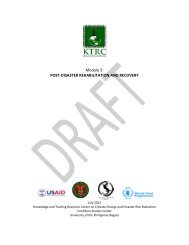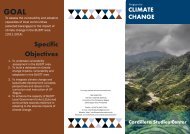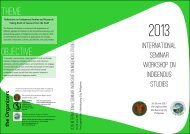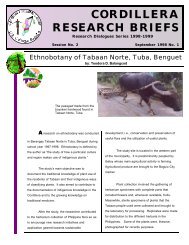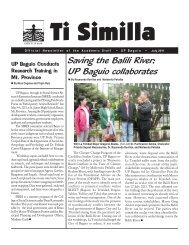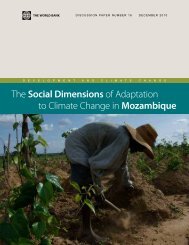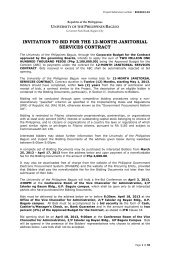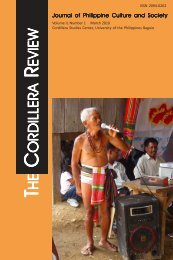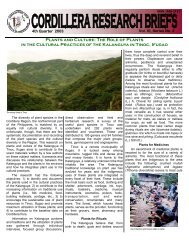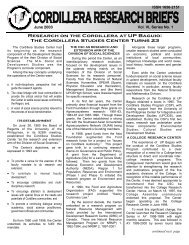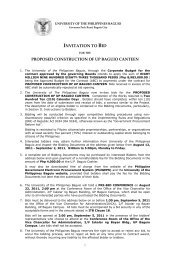Pambansang Summit sa W ambansang Summit sa W ... - UP Baguio
Pambansang Summit sa W ambansang Summit sa W ... - UP Baguio
Pambansang Summit sa W ambansang Summit sa W ... - UP Baguio
You also want an ePaper? Increase the reach of your titles
YUMPU automatically turns print PDFs into web optimized ePapers that Google loves.
The Department of<br />
Biology, in cooperation with<br />
the Lecture Series Committee<br />
of the College of Science,<br />
conducted a seminarworkshop<br />
entitled “Model<br />
Organisms for Biological and<br />
Biomedical Researches” on<br />
March 7, 2011. Aimed at<br />
encouraging colleagues in the<br />
academe to further their<br />
research activities, the<br />
Department chose the<br />
workshop topic as many<br />
biological researches involve<br />
the use of model organisms<br />
to evaluate, validate, and even<br />
to establish scientific<br />
concepts.<br />
The value of model<br />
organisms in scientific researches was<br />
highlighted by Dr. Paul Medina, a<br />
recipient of the Balik-Scientist Program<br />
of the Department of Science and<br />
Technology (DOST). As Medina<br />
mentioned in his two-part lecture, a model<br />
organism is a non-human species that is<br />
extensively studied to understand<br />
particular biological phenomena, with the<br />
expectation that discoveries made in the<br />
model organism will provide insight into<br />
the workings of other organisms. He<br />
underscored that a model organism is an<br />
alternative to using human subjects when<br />
the nature of the experiment makes it<br />
impractical or less ethical to do so.<br />
In his lecture, Dr. Medina shared his<br />
experiences and knowledge in handling<br />
some of the commonly used model<br />
organisms. Such include Escherichia coli<br />
(bacterium), Saccharomyces cerevisiae<br />
(yeast), Ceanorhabditis elegans (nematode),<br />
Mus musculus (mouse), Daphnia (water<br />
flea), and Drosophila melanogaster (fruit<br />
fly).<br />
8 TI SIMILLA April 2011<br />
Lecture<br />
Model organisms as tools<br />
in biological research<br />
By Karen Ballada and Deemson Mones<br />
Daphnia (water flea)<br />
E. coli, a gram negative bacterium, is<br />
perhaps the most well studied organism.<br />
While it is a common enteric bacterium,<br />
most laboratory E. coli have lost their<br />
ability to thrive in the intestines. E. coli<br />
DNA material consists of a single<br />
bacterial “chromosome” and multiple<br />
plasmids. E.coli is commonly used in<br />
recombinant DNA technology. Yeast, on<br />
the other hand, is another example of a<br />
microorganism often used as a model<br />
organism. It is a single, free-living cell,<br />
only 3 microns in diameter (4,000 of them<br />
lined up would measure an inch). It<br />
reproduces by budding and doubles every<br />
90 minutes, has 12 million base pairs of<br />
DNA, and has 6,000 genes, of which at<br />
least 31 percent have human equivalents.<br />
Hybridized yeast strains are being utilized<br />
in researches. These properties of the<br />
above-mentioned organisms make them<br />
good models to study bacterial and yeast<br />
transformations associated with biological<br />
phenomena.<br />
Studies contribute to medical<br />
research on human diseases<br />
Another model<br />
discussed in Dr.<br />
Medina’s lecture is<br />
the C. elegans, a freeliving<br />
(not parasitic)<br />
nematode living in<br />
soil and feeding on<br />
bacteria that thrive<br />
on decaying vegetal<br />
matter. N2 strain (a<br />
hybrid) is used in<br />
research and has<br />
been a model<br />
organism since 1974.<br />
It is the first<br />
organism whose<br />
genome was<br />
completely<br />
sequenced. C. elegans<br />
genome size is<br />
relatively small (9.7 x 10 7 base pairs or 97<br />
Megabases) consisting of 5 pairs of<br />
autosomes and a pair sex chromosome.<br />
About 35% of C. elegans genes have<br />
human homologs and human genes<br />
replace their C. elegans homologs when<br />
introduced into C. elegans. Such<br />
characteristics make C. elegans a perfect<br />
model for researches and has been<br />
employed in studies such as in autism,<br />
drug testing, kidney diseases, aging,<br />
circadian rhythm clock, herbal effects,<br />
and drug discoveries.<br />
Daphnia (water flea), on the other<br />
hand, is an organism used as fish food. It<br />
is also currently utilized in bioas<strong>sa</strong>y of<br />
chemicals in freshwaters, such as<br />
pollutants and toxins (an ecotoxicological<br />
indicator). Its high fecundity makes it the<br />
standard in toxicological testing of<br />
freshwater. So far, there are over 100<br />
species of water flea but the most studied<br />
are Daphnia pulex and Daphnia magna<br />
species. Unfortunately, Daphnia is not<br />
naturally found in the Philippines, though





